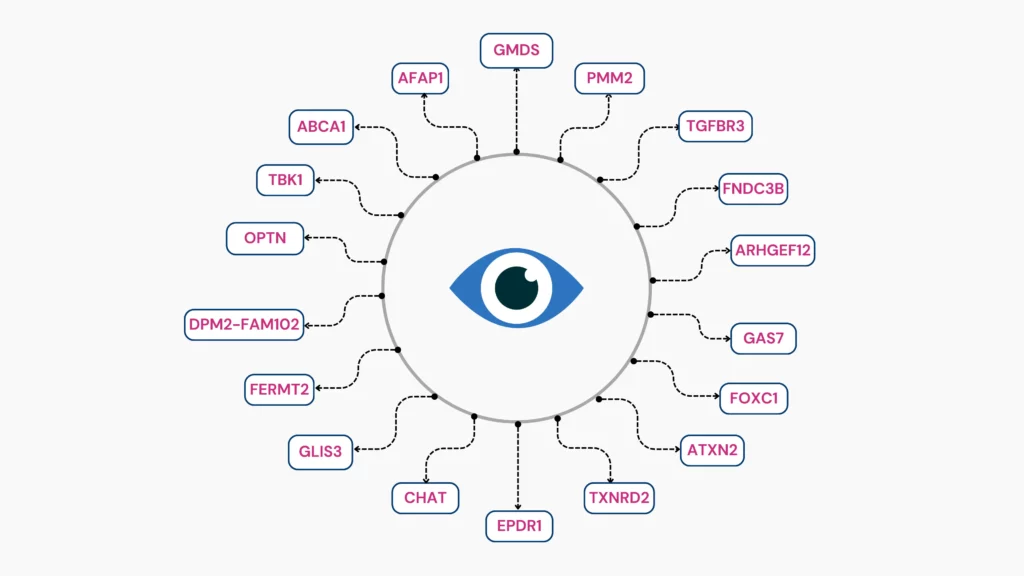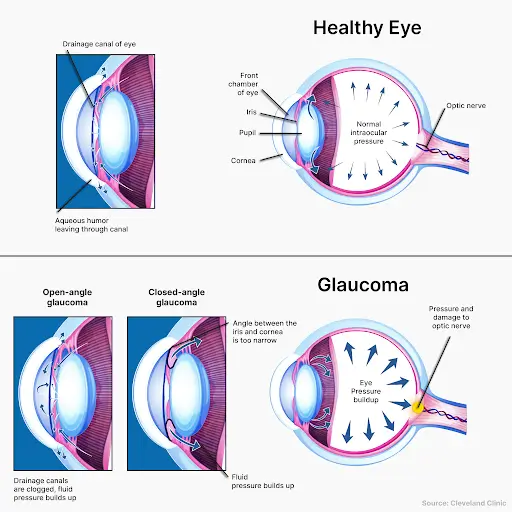Millions of Americans unwittingly endure glaucoma, an invisible cause of vision problems every year. The early symptoms of glaucoma can be hard to diagnose, so people don’t usually find out until it’s too late. Genetic mutations are one of the leading causes of glaucoma, and regular genetic and eye testing can help diagnose it in time, especially for those with a positive family history of the disease. Read on to learn about glaucoma, its genetic risk factors, its causes, and how to identify if you’re at risk.
What Is Glaucoma?
Glaucoma is a hereditary condition that damages the optic nerve.
This nerve sends visual signals from the eye to the brain, helping you understand what you see.
Glaucoma progresses slowly. There are no clear early signs of this disease, and most people don’t seek medical attention until they notice a decline in their vision.
People with a genetic risk for the condition may need regular eye exams to monitor their optic nerve health and intraocular pressure (IOP).
What Causes Glaucoma?
High IOP is the main culprit of glaucoma.
A lubricant called aqueous humor circulates within the anterior chamber of the eye. In order to maintain a stable IOP, it is drained out of the eye regularly.
If this drainage system is blocked, the aqueous humor builds up in the eye, increasing the IOP.
Pressure builds on the optic nerve, gradually causing the death of optic nerve fibers, leading to blind spots and poor vision.
Risk Factors For Glaucoma
- Age: The risk of glaucoma increases strongly in people above 40 years of age.
- Family history: Nearly 50% of all cases of open-angle glaucoma have a first-degree relative with the condition.
- Race: A genetic review on the prevalence of OAG showed that the prevalence of OAG was highest in African-American people (3.4%), followed by Caucasians (1.7%) and Hispanics (1.5%).
- Existing conditions: Diabetes, myopia, and high or low blood pressure could all lead to glaucoma.
Is Glaucoma Hereditary?
Research has shown that some forms of glaucoma are hereditary and can be passed down through generations.
Glaucoma is inherited in either an autosomal dominant or autosomal recessive manner.
In autosomal dominant inheritance, only one copy of the mutated gene from either parent is needed to express itself in both the parent and the offspring. Juvenile glaucoma is inherited in this manner.
In autosomal recessive inheritance, both parents must carry one copy of the mutated gene (in its recessive state), and the child must inherit both copies to be at risk for glaucoma. Congenital glaucoma is inherited in this manner.
Does Glaucoma Always Run In Families?
Some variants of glaucoma may run in the family. The parents may be carriers of the mutated genes and not develop the condition themselves while passing it on to their children.
Sometimes, existing risk factors like hypertension, hypotension, diabetes, age, or eye injury in families could lead to the development of glaucoma.
What Gender Is Most Likely To Get Glaucoma?
A meta-analysis studied 46 published observational research papers to find gender-based risk factors for developing OAG.
The results found that men were 1.4 times more likely to develop glaucoma than women.
Genes Implicated In Glaucoma

MYOC Gene Mutations
The myocilin (MYOC) gene produces the myocilin protein, which is essential for maintaining IOP.
Scientists have identified at least a hundred variations of the MYOC gene.
These variations may lead to the underproduction of myocilin, leading to increased intraocular pressure and glaucoma.
About 4% of all cases of primary OAG and more than 10% of all cases of juvenile OAG are due to MYOC mutations.
CYP1B1 Gene Mutations
The Cytochrome P450 family 1 subfamily B member 1 (CYP1B1) gene produces the CYP1B1 enzyme.
Researchers have studied over 100 variations of this gene.
50% of all cases of primary congenital glaucoma are due to mutations in this gene at the GLC3A locus.
LTBP2 Gene Mutations
The Latent Transforming Growth Factor Beta Binding Protein 2 (LTBP2) gene produces the LTBP2 protein, which forms the anterior chambers of the eye.
A study found that null mutations in this gene could lead to an increased risk of developing PCG.
While these 3 are the most researched genes for glaucoma, other genes also play a minor role in causing the disease.
Did You Know?
Changes in certain genes can increase your risk for many chronic health conditions, including glaucoma. Learn more:
What Types Of Glaucoma Are Hereditary?
Primary Open-angle Glaucoma
Increased IOP slowly damages the optic nerve over time, leading to open-angle glaucoma (OAG)
Though it doesn’t show early symptoms, it could lead to blurry vision and the gradual loss of both peripheral and central vision.
A 2011 study reports that single-gene mutations cause 5% of all POAG.
For instance, mutations in the MYOC gene can cause juvenile open-angle glaucoma.
Multiple mutations and environmental risk factors can lead to the other 95% of cases.
Early-onset Glaucoma
Early-onset glaucoma is a type diagnosed before the age of 40 in adults.
This type is primarily hereditary and may occur even without related risk factors.
A majority of early-onset glaucoma cases turn out to be primary open-angle glaucoma.
Early-onset glaucoma is generally inherited in an autosomal recessive manner- meaning that while parents may carry one copy of the gene, the disease will not be inherited unless the child carries both copies.
Primary Congenital Glaucoma
Congenital glaucoma occurs in infants before the age of three, leading to optic nerve damage and vision loss.
Infants with congenital glaucoma generally exhibit red or cloudy eyes, an increased rate of blinking, light sensitivity, and tear production without crying.
Congenital glaucoma could be due to complications affecting the infant’s eye as a fetus.
Studies say that variations in the CYP1B1 or LTBP2 genes could lead to the development of primary congenital glaucoma in infants under the age of three.
Juvenile Open-angle Glaucoma
Juvenile OAG (JOAG), diagnosed in childhood or early adulthood, is called juvenile open-angle glaucoma.
The cause and prognosis of the disease are the same.
Juvenile OAG is inherited in an autosomal dominant manner, meaning that if even one parent carries a MYOC gene with the specific mutation responsible for JOAG, the child will end up with JOAG.

Non-hereditary Types Of Glaucoma
Angle-closure Glaucoma
Angle-closure glaucoma (ACG) occurs when the IOP suddenly increases, stopping the movement of the aqueous humor in the eye.
Since this is an acute attack, it presents with headaches, nausea, and eye pain. The vision turns blurry, and halos are visible around light sources.
ACG generally presents in one eye at a time. With timely medical aid, doctors could save the other eye.
Normal-tension Glaucoma
Interestingly, normal-tension glaucoma damages the optic nerve without an increase in IOP.
Instead, normal-tension glaucoma could develop due to poor blood flow to the optic nerves or some other inherited trait.
Secondary Glaucoma
Secondary glaucoma is the development of either open-angle or angle-closure glaucoma due to a separate condition, such as:
- Health conditions like diabetes or hypertension
- Eye diseases or infections
- Injury to the eye
- Use of certain medicines that can increase eye pressure
Identifying Your Genetic Risk For Glaucoma
Analyzing your genes can also help you understand your risk of developing the disease.
Genetic testing is beneficial in identifying early-onset glaucoma if the condition begins manifesting itself in people under 40 years of age.
Suppose genetic testing reveals a higher risk of developing glaucoma. In that case, you may need regular eye exams done by an eye doctor to diagnose the condition before it worsens.
In fact, a comprehensive eye exam once every two years can be beneficial to anyone whose first-degree relatives are diagnosed with glaucoma.
Frequently Asked Questions
Can I Lower my IOP By Drinking Water?
Water helps lower IOP if consumed in moderation. Drinking too much water in a short time can lead to increased IOP.
What Is The Life Expectancy With Glaucoma?
Glaucoma is not a fatal condition. It will neither increase your mortality risk nor lead to fatal complications.
Can Stress Lead To Glaucoma?
Stress does not directly lead to open-angle glaucoma. However, patients who are regularly overwhelmed may neglect their treatment courses, which could worsen their condition.
Summary: Is Glaucoma Hereditary?
- Studies have identified genes such as MYOC, CYP1B1, and LTBP2 contributing to an increased glaucoma risk.
- If you have a positive family history of glaucoma, experts recommend that you get regular eye checkups done.
- Glaucoma is a form of blindness caused by damage to the optic nerve due to high intraocular pressure.
- There are seven kinds of glaucoma, namely: primary open-angle glaucoma (POAG), angle-closure glaucoma, normal-tension glaucoma, early-onset glaucoma, juvenile open-angle glaucoma, congenital glaucoma, and secondary glaucoma
- Glaucoma can be inherited from either or both parents, depending on the inheritance pattern.
- Other risk factors to watch out for include age, family history, race, and existing health conditions like diabetes, myopia, and blood pressure issues.
References
- Glaucoma | National Eye Institute
- What Is Glaucoma? Symptoms, Causes, Diagnosis, Treatment - American Academy of Ophthalmology
- Glaucoma history and risk factors - PMC
- Myopia: A close look at efforts to turn back a growing problem
- Early-onset glaucoma: MedlinePlus Genetics
- About Glaucoma | Vision and Eye Health | CDC
- Diabetes Mellitus as a Risk Factor for Open-Angle Glaucoma: A Systematic Review and Meta-Analysis - PMC
- Primary Congenital Glaucoma - GeneReviews® - NCBI Bookshelf (nih.gov)
- Variations in primary open-angle glaucoma prevalence by age, gender, and race: a Bayesian meta-analysis
- Genetics of glaucoma - PMC
- Myocilin-associated Glaucoma: A Historical Perspective and Recent Research Progress - PMC
- Null Mutations in LTBP2 Cause Primary Congenital Glaucoma - PMC
- LTBP2 - an overview | ScienceDirect Topics
- Childhood Glaucoma Genes and Phenotypes: Focus on FOXC1 mutations causing anterior segment dysgenesis and hearing loss - PMC
- LTBP2 Gene - Latent Transforming Growth Factor Beta Binding Protein 2
- early-onset-glaucoma.pdf (medlineplus.gov)
- Glaucoma - Diagnosis and treatment - Mayo Clinic




